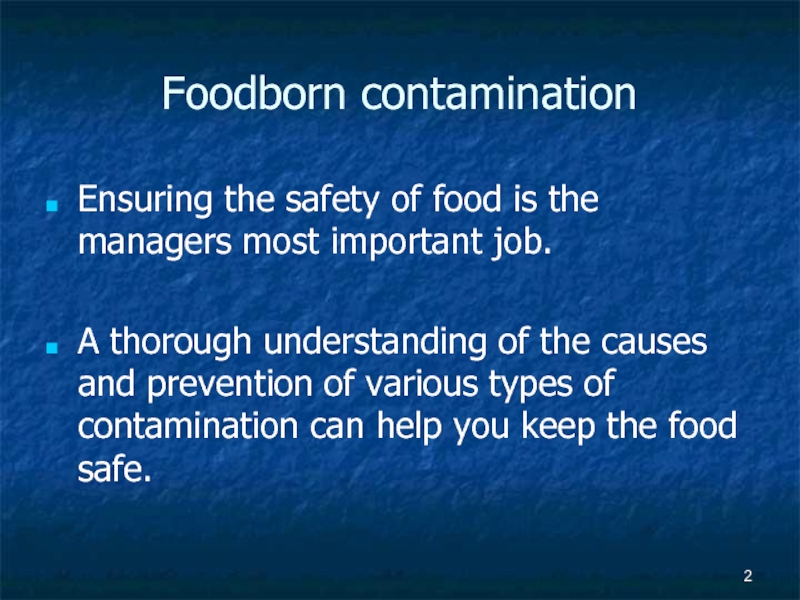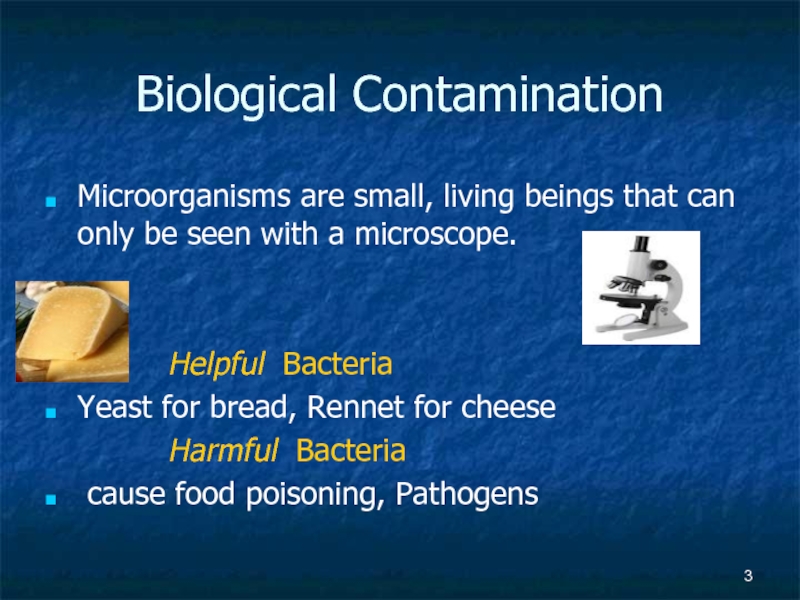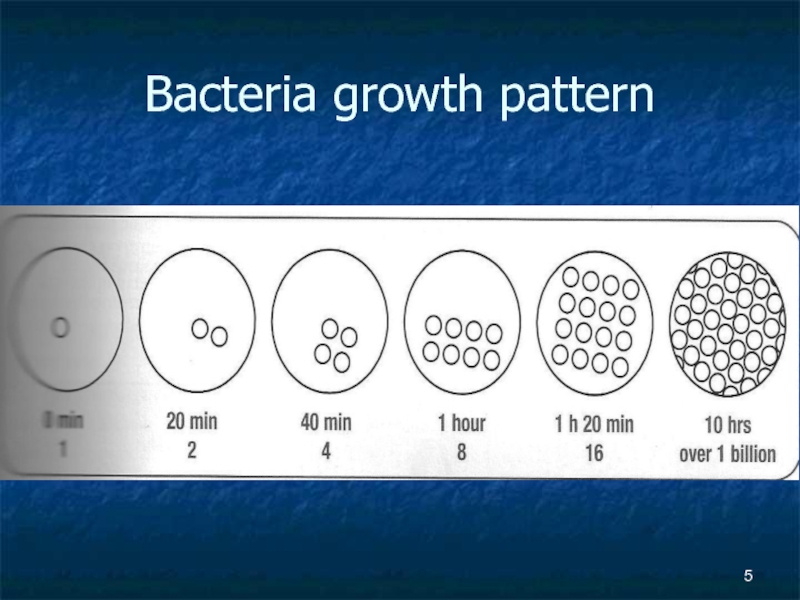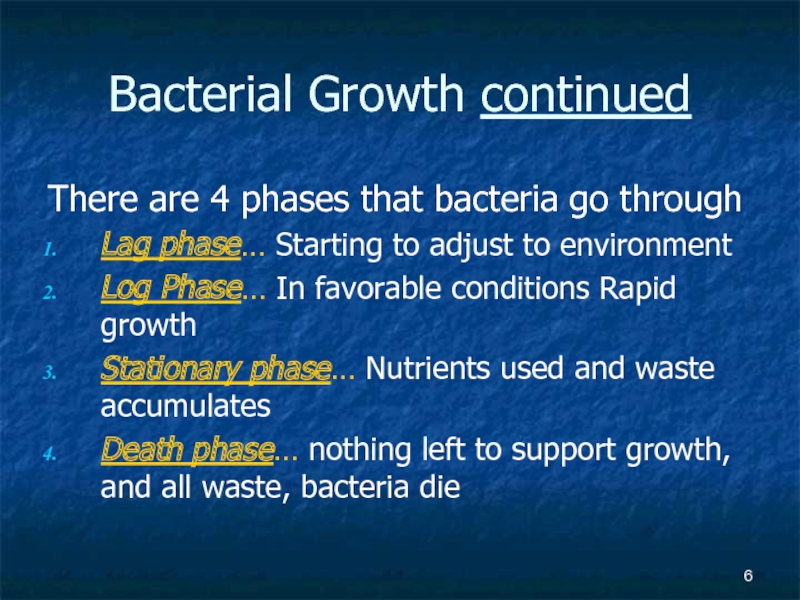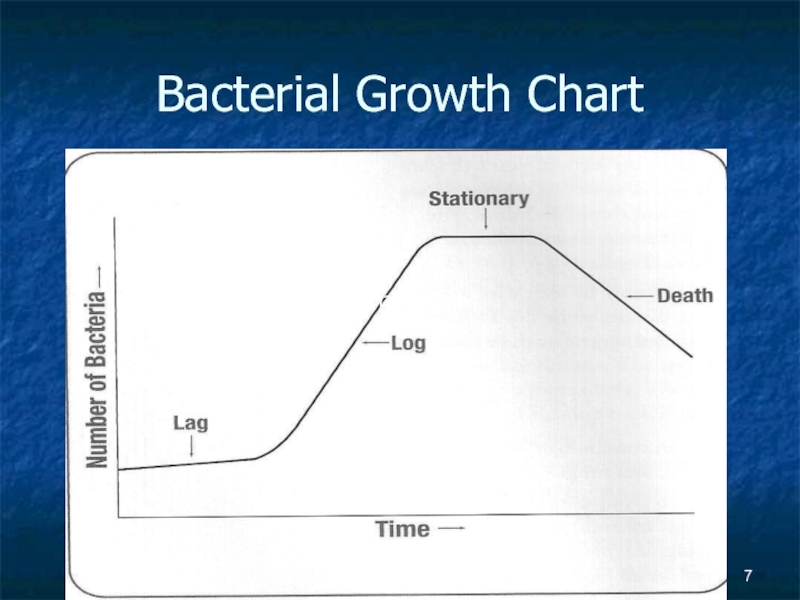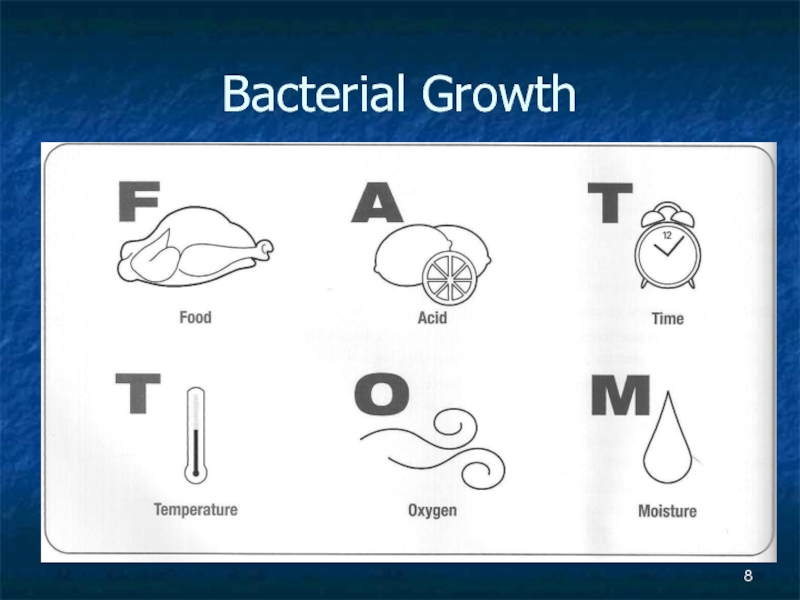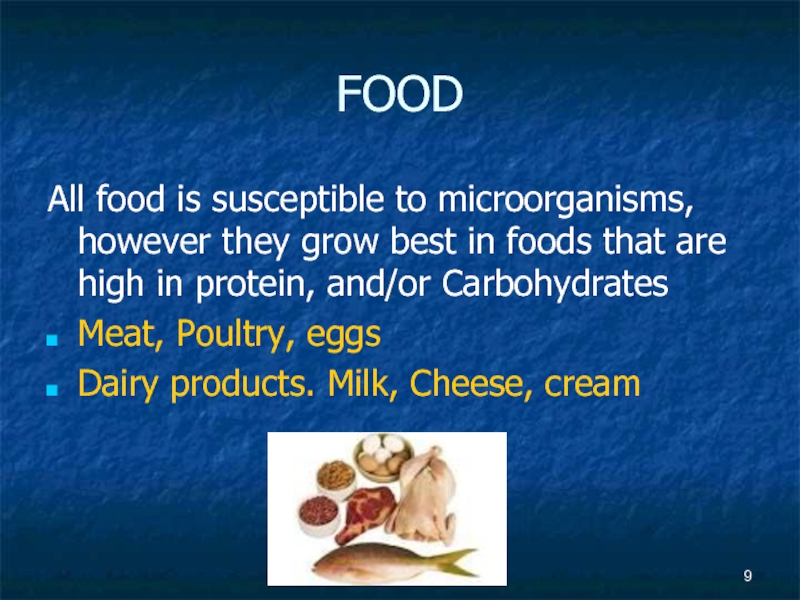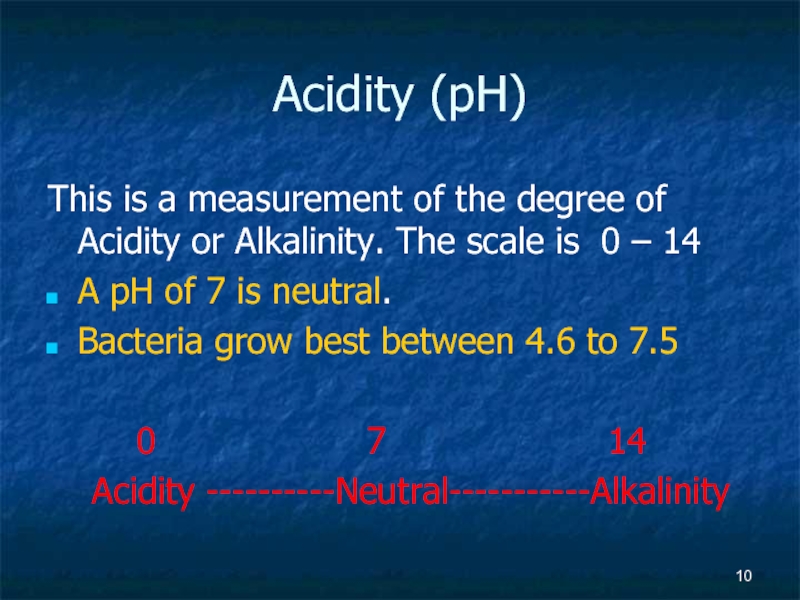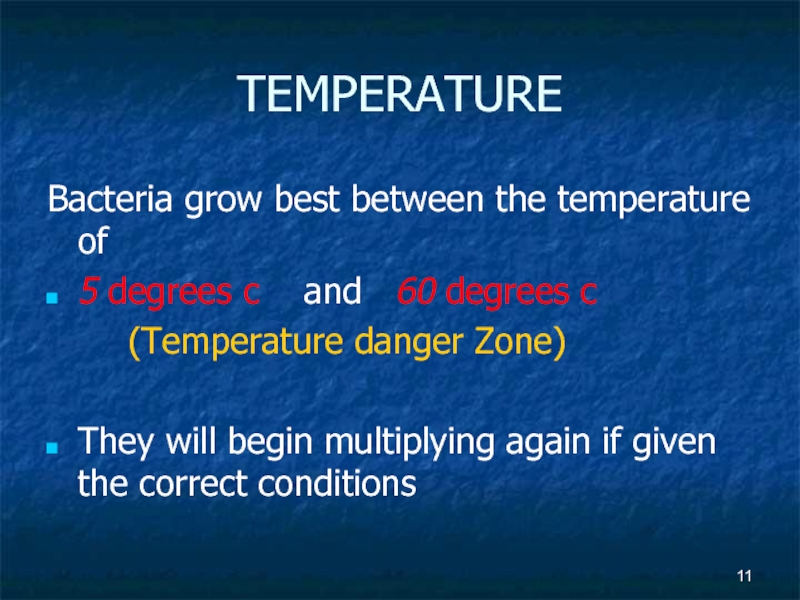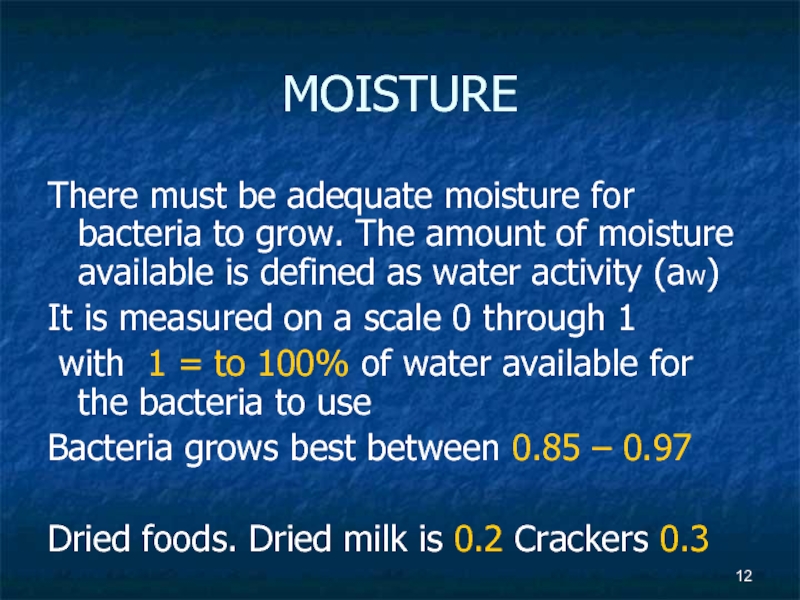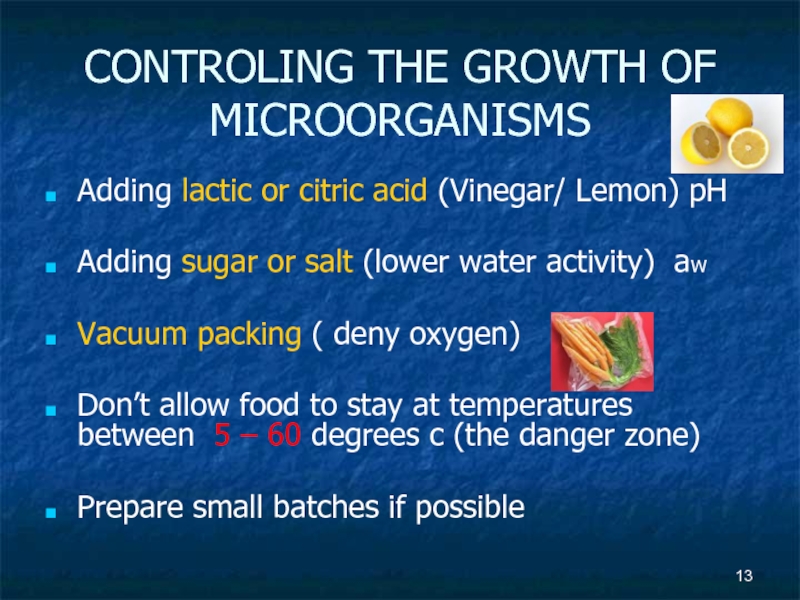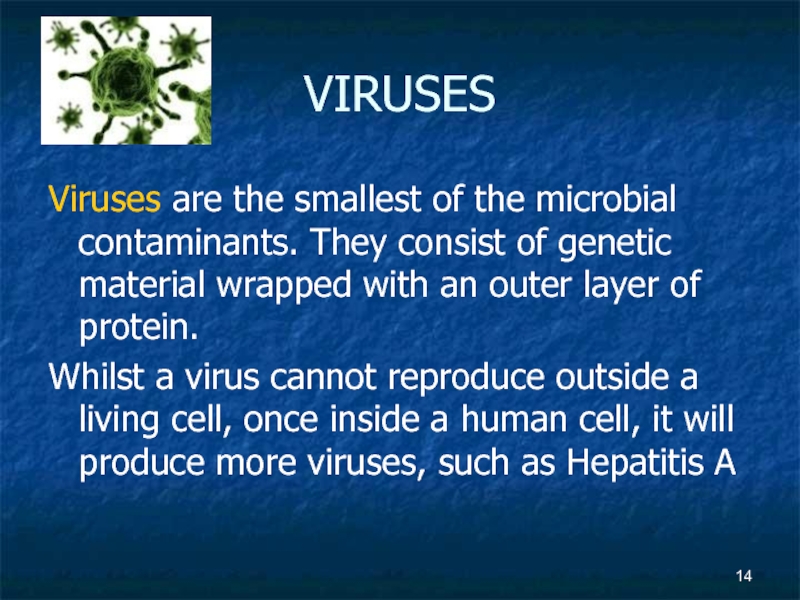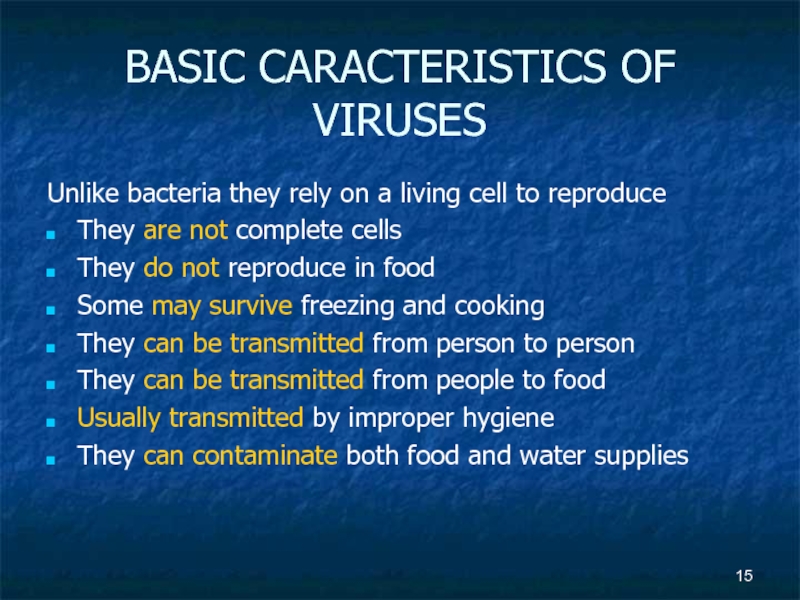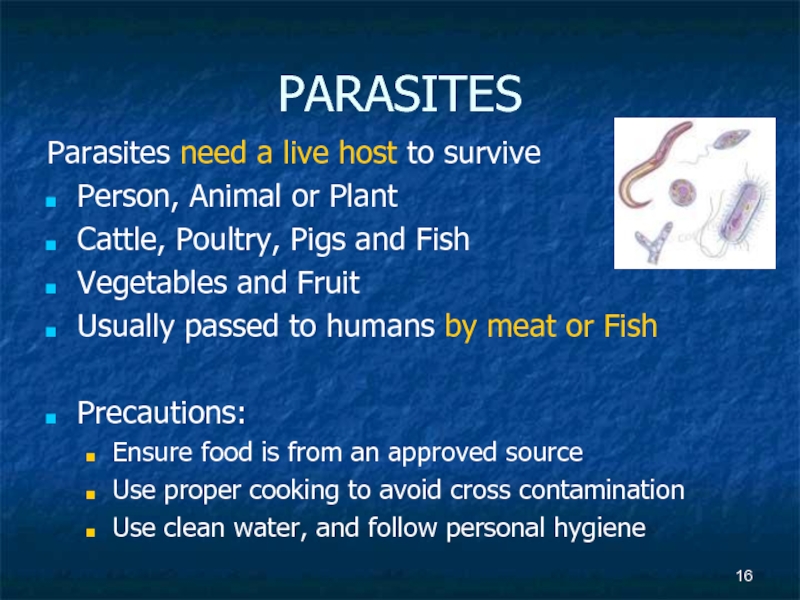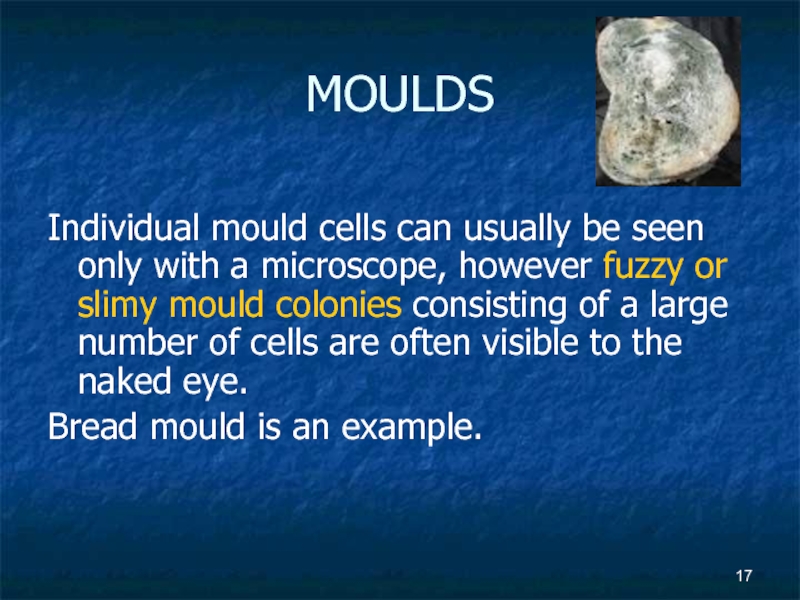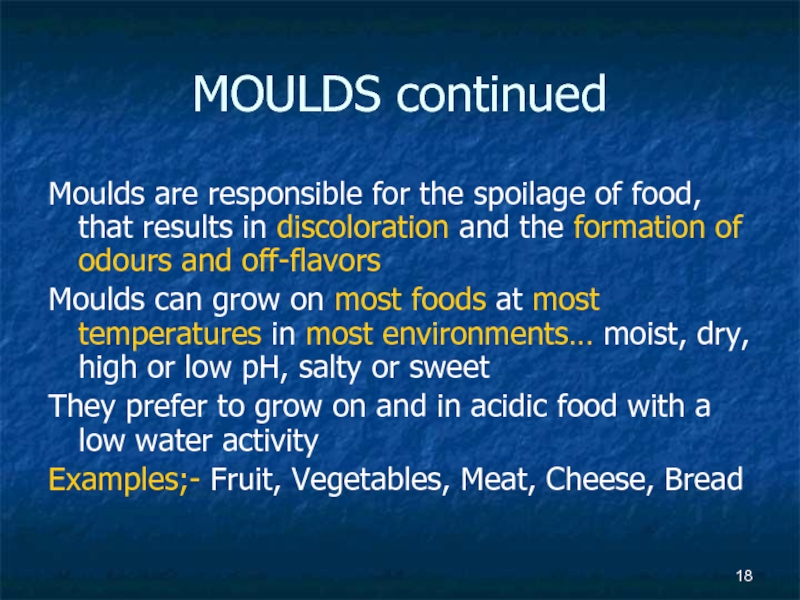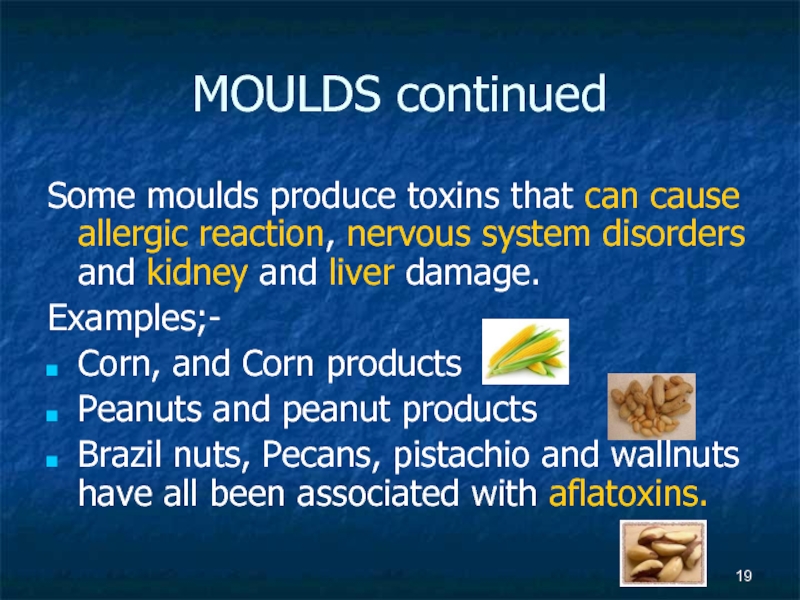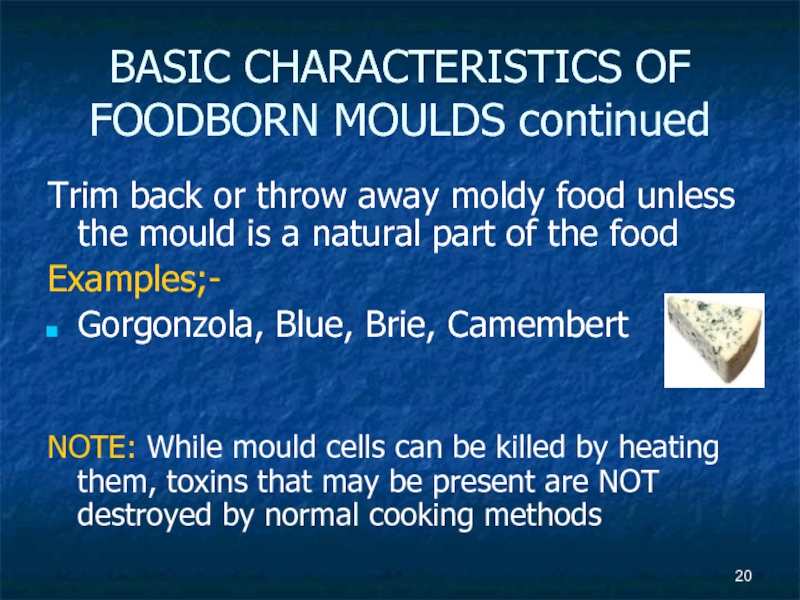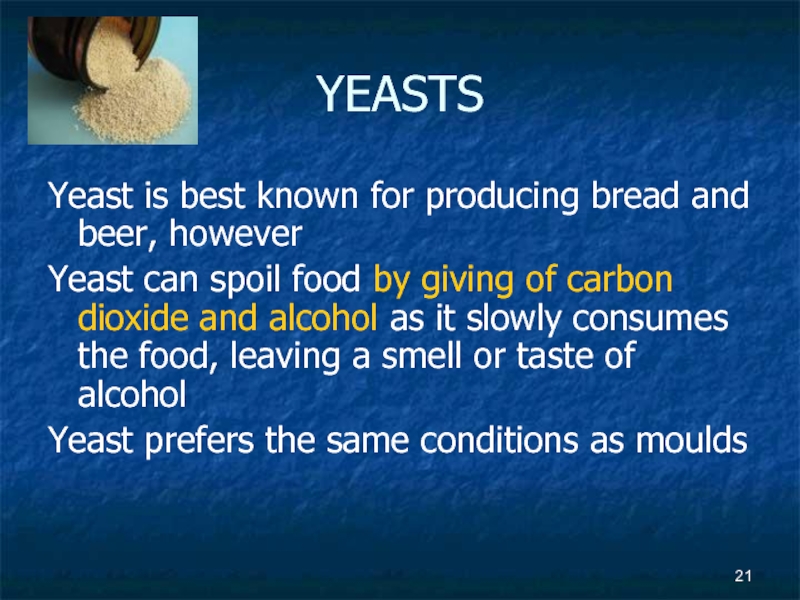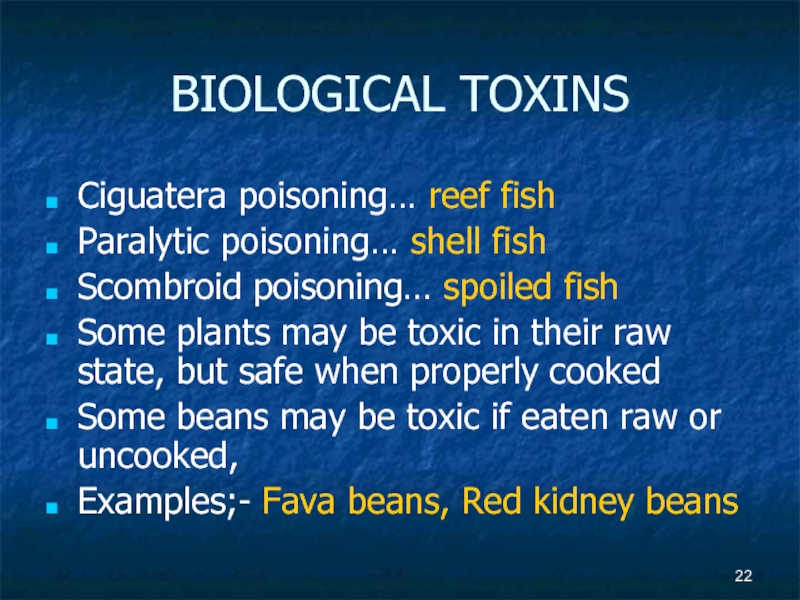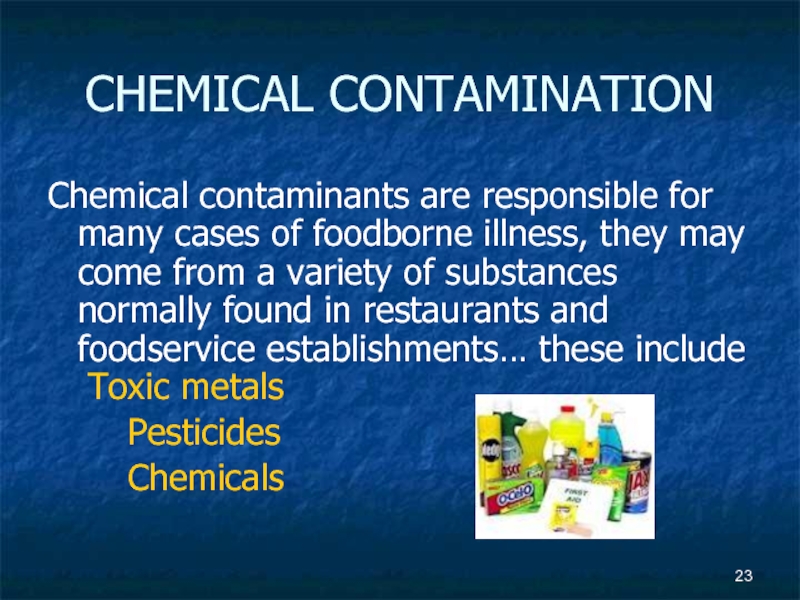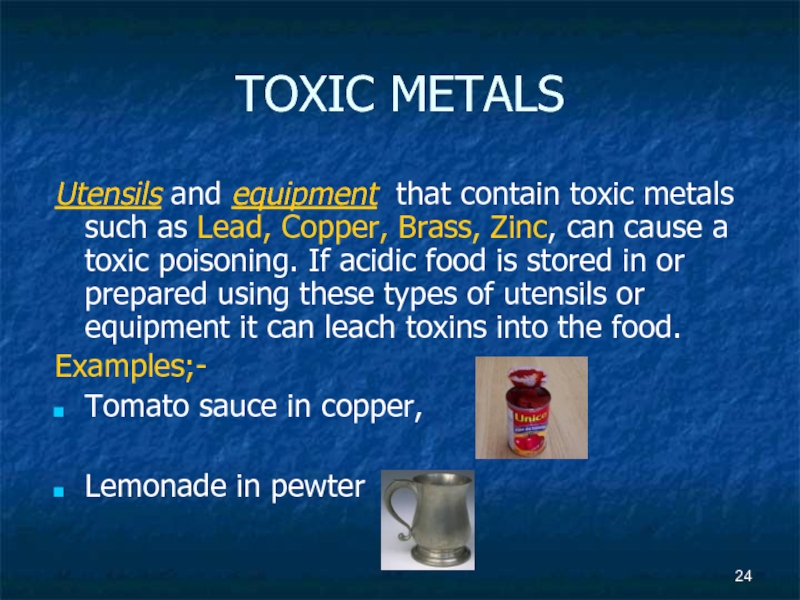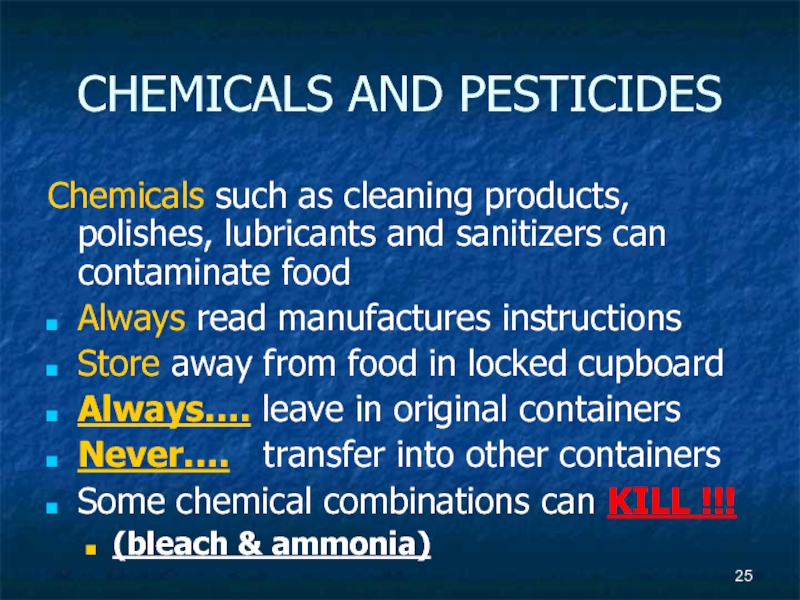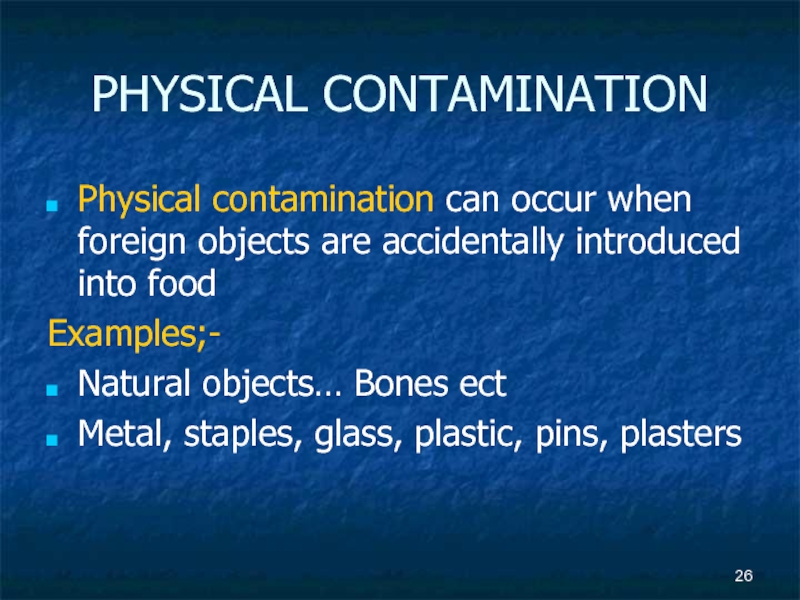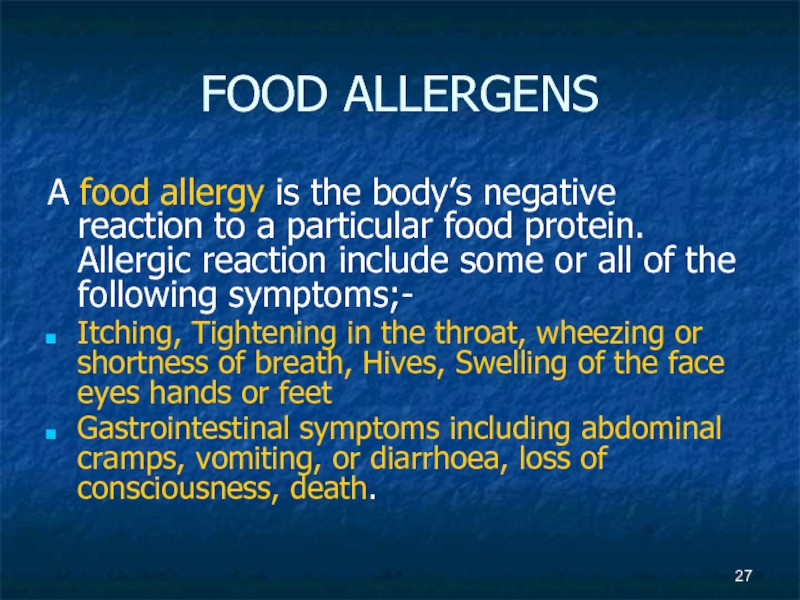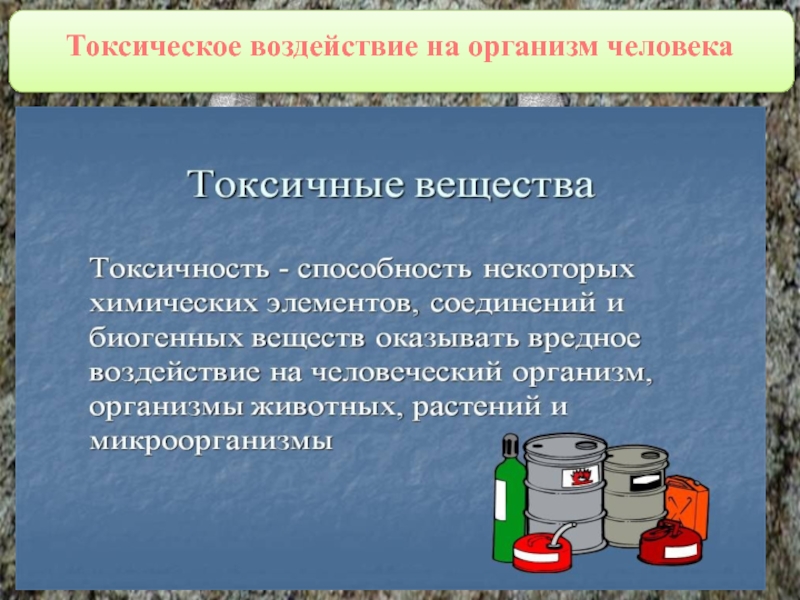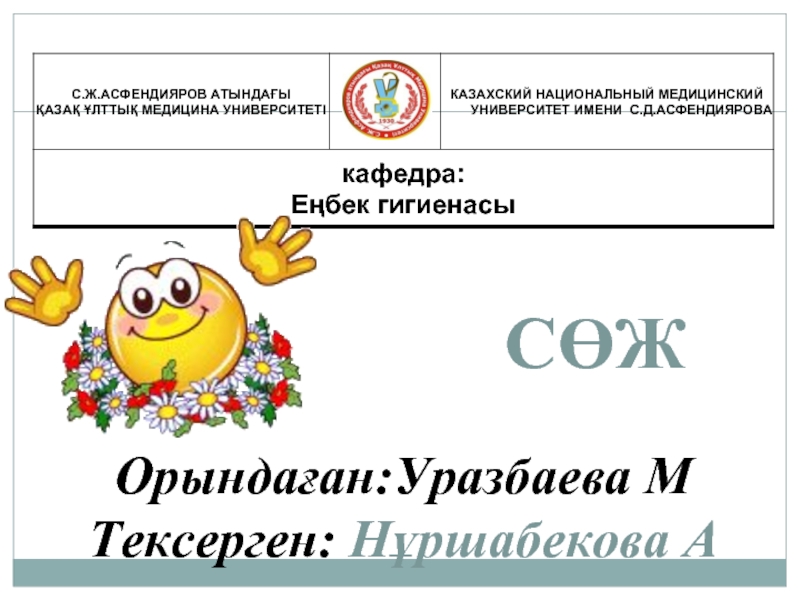- Главная
- Разное
- Дизайн
- Бизнес и предпринимательство
- Аналитика
- Образование
- Развлечения
- Красота и здоровье
- Финансы
- Государство
- Путешествия
- Спорт
- Недвижимость
- Армия
- Графика
- Культурология
- Еда и кулинария
- Лингвистика
- Английский язык
- Астрономия
- Алгебра
- Биология
- География
- Детские презентации
- Информатика
- История
- Литература
- Маркетинг
- Математика
- Медицина
- Менеджмент
- Музыка
- МХК
- Немецкий язык
- ОБЖ
- Обществознание
- Окружающий мир
- Педагогика
- Русский язык
- Технология
- Физика
- Философия
- Химия
- Шаблоны, картинки для презентаций
- Экология
- Экономика
- Юриспруденция
Food, science, hygiene. (Chapter 2) презентация
Содержание
- 1. Food, science, hygiene. (Chapter 2)
- 2. Foodborn contamination Ensuring the safety of food
- 3. Biological Contamination Microorganisms are small, living beings
- 4. Bacteria Smallest living celled organisms Found in
- 5. Bacteria growth pattern
- 6. Bacterial Growth continued There are 4 phases
- 7. Bacterial Growth Chart Bacterial Growth
- 8. Bacterial Growth
- 9. FOOD All food is susceptible to microorganisms,
- 10. Acidity (pH) This is a measurement of
- 11. TEMPERATURE Bacteria grow best between the temperature
- 12. MOISTURE There must be adequate moisture for
- 13. CONTROLING THE GROWTH OF MICROORGANISMS Adding lactic
- 14. VIRUSES Viruses are the smallest of the
- 15. BASIC CARACTERISTICS OF VIRUSES Unlike bacteria they
- 16. PARASITES Parasites need a live host to
- 17. MOULDS Individual mould cells can usually be
- 18. MOULDS continued Moulds are responsible for the
- 19. MOULDS continued Some moulds produce toxins that
- 20. BASIC CHARACTERISTICS OF FOODBORN MOULDS continued Trim
- 21. YEASTS Yeast is best known for producing
- 22. BIOLOGICAL TOXINS Ciguatera poisoning… reef fish Paralytic
- 23. CHEMICAL CONTAMINATION Chemical contaminants are responsible for
- 24. TOXIC METALS Utensils and equipment that contain
- 25. CHEMICALS AND PESTICIDES Chemicals such as cleaning
- 26. PHYSICAL CONTAMINATION Physical contamination can occur when
- 27. FOOD ALLERGENS A food allergy is the
Слайд 2Foodborn contamination
Ensuring the safety of food is the managers most important
job.
A thorough understanding of the causes and prevention of various types of contamination can help you keep the food safe.
A thorough understanding of the causes and prevention of various types of contamination can help you keep the food safe.
Слайд 3Biological Contamination
Microorganisms are small, living beings that can only be seen
with a microscope.
Helpful Bacteria
Yeast for bread, Rennet for cheese
Harmful Bacteria
cause food poisoning, Pathogens
Helpful Bacteria
Yeast for bread, Rennet for cheese
Harmful Bacteria
cause food poisoning, Pathogens
Слайд 4Bacteria
Smallest living celled organisms
Found in Food, Water, Soil, Humans, Insects
They can
reproduce every 20 mins ( double )
Some can survive freezing
Some can turn into spores to protect themselves
Some can produce toxins as they multiply, die and break-down. These are not destroyed by cooking
Some can survive freezing
Some can turn into spores to protect themselves
Some can produce toxins as they multiply, die and break-down. These are not destroyed by cooking
Слайд 6Bacterial Growth continued
There are 4 phases that bacteria go through
Lag phase…
Starting to adjust to environment
Log Phase… In favorable conditions Rapid growth
Stationary phase… Nutrients used and waste accumulates
Death phase… nothing left to support growth, and all waste, bacteria die
Log Phase… In favorable conditions Rapid growth
Stationary phase… Nutrients used and waste accumulates
Death phase… nothing left to support growth, and all waste, bacteria die
Слайд 9FOOD
All food is susceptible to microorganisms, however they grow best in
foods that are high in protein, and/or Carbohydrates
Meat, Poultry, eggs
Dairy products. Milk, Cheese, cream
Meat, Poultry, eggs
Dairy products. Milk, Cheese, cream
Слайд 10Acidity (pH)
This is a measurement of the degree of Acidity or
Alkalinity. The scale is 0 – 14
A pH of 7 is neutral.
Bacteria grow best between 4.6 to 7.5
0 7 14
Acidity ----------Neutral-----------Alkalinity
A pH of 7 is neutral.
Bacteria grow best between 4.6 to 7.5
0 7 14
Acidity ----------Neutral-----------Alkalinity
Слайд 11TEMPERATURE
Bacteria grow best between the temperature of
5 degrees c
and 60 degrees c
(Temperature danger Zone)
They will begin multiplying again if given the correct conditions
(Temperature danger Zone)
They will begin multiplying again if given the correct conditions
Слайд 12MOISTURE
There must be adequate moisture for bacteria to grow. The amount
of moisture available is defined as water activity (aw)
It is measured on a scale 0 through 1
with 1 = to 100% of water available for the bacteria to use
Bacteria grows best between 0.85 – 0.97
Dried foods. Dried milk is 0.2 Crackers 0.3
It is measured on a scale 0 through 1
with 1 = to 100% of water available for the bacteria to use
Bacteria grows best between 0.85 – 0.97
Dried foods. Dried milk is 0.2 Crackers 0.3
Слайд 13CONTROLING THE GROWTH OF MICROORGANISMS
Adding lactic or citric acid (Vinegar/ Lemon)
pH
Adding sugar or salt (lower water activity) aw
Vacuum packing ( deny oxygen)
Don’t allow food to stay at temperatures between 5 – 60 degrees c (the danger zone)
Prepare small batches if possible
Adding sugar or salt (lower water activity) aw
Vacuum packing ( deny oxygen)
Don’t allow food to stay at temperatures between 5 – 60 degrees c (the danger zone)
Prepare small batches if possible
Слайд 14VIRUSES
Viruses are the smallest of the microbial contaminants. They consist of
genetic material wrapped with an outer layer of protein.
Whilst a virus cannot reproduce outside a living cell, once inside a human cell, it will produce more viruses, such as Hepatitis A
Whilst a virus cannot reproduce outside a living cell, once inside a human cell, it will produce more viruses, such as Hepatitis A
Слайд 15BASIC CARACTERISTICS OF VIRUSES
Unlike bacteria they rely on a living cell
to reproduce
They are not complete cells
They do not reproduce in food
Some may survive freezing and cooking
They can be transmitted from person to person
They can be transmitted from people to food
Usually transmitted by improper hygiene
They can contaminate both food and water supplies
They are not complete cells
They do not reproduce in food
Some may survive freezing and cooking
They can be transmitted from person to person
They can be transmitted from people to food
Usually transmitted by improper hygiene
They can contaminate both food and water supplies
Слайд 16PARASITES
Parasites need a live host to survive
Person, Animal or Plant
Cattle, Poultry,
Pigs and Fish
Vegetables and Fruit
Usually passed to humans by meat or Fish
Precautions:
Ensure food is from an approved source
Use proper cooking to avoid cross contamination
Use clean water, and follow personal hygiene
Vegetables and Fruit
Usually passed to humans by meat or Fish
Precautions:
Ensure food is from an approved source
Use proper cooking to avoid cross contamination
Use clean water, and follow personal hygiene
Слайд 17MOULDS
Individual mould cells can usually be seen only with a microscope,
however fuzzy or slimy mould colonies consisting of a large number of cells are often visible to the naked eye.
Bread mould is an example.
Bread mould is an example.
Слайд 18MOULDS continued
Moulds are responsible for the spoilage of food, that results
in discoloration and the formation of odours and off-flavors
Moulds can grow on most foods at most temperatures in most environments… moist, dry, high or low pH, salty or sweet
They prefer to grow on and in acidic food with a low water activity
Examples;- Fruit, Vegetables, Meat, Cheese, Bread
Moulds can grow on most foods at most temperatures in most environments… moist, dry, high or low pH, salty or sweet
They prefer to grow on and in acidic food with a low water activity
Examples;- Fruit, Vegetables, Meat, Cheese, Bread
Слайд 19MOULDS continued
Some moulds produce toxins that can cause allergic reaction, nervous
system disorders and kidney and liver damage.
Examples;-
Corn, and Corn products
Peanuts and peanut products
Brazil nuts, Pecans, pistachio and wallnuts have all been associated with aflatoxins.
Examples;-
Corn, and Corn products
Peanuts and peanut products
Brazil nuts, Pecans, pistachio and wallnuts have all been associated with aflatoxins.
Слайд 20BASIC CHARACTERISTICS OF FOODBORN MOULDS continued
Trim back or throw away moldy
food unless the mould is a natural part of the food
Examples;-
Gorgonzola, Blue, Brie, Camembert
NOTE: While mould cells can be killed by heating them, toxins that may be present are NOT destroyed by normal cooking methods
Examples;-
Gorgonzola, Blue, Brie, Camembert
NOTE: While mould cells can be killed by heating them, toxins that may be present are NOT destroyed by normal cooking methods
Слайд 21YEASTS
Yeast is best known for producing bread and beer, however
Yeast can
spoil food by giving of carbon dioxide and alcohol as it slowly consumes the food, leaving a smell or taste of alcohol
Yeast prefers the same conditions as moulds
Yeast prefers the same conditions as moulds
Слайд 22BIOLOGICAL TOXINS
Ciguatera poisoning… reef fish
Paralytic poisoning… shell fish
Scombroid poisoning… spoiled fish
Some
plants may be toxic in their raw state, but safe when properly cooked
Some beans may be toxic if eaten raw or uncooked,
Examples;- Fava beans, Red kidney beans
Some beans may be toxic if eaten raw or uncooked,
Examples;- Fava beans, Red kidney beans
Слайд 23CHEMICAL CONTAMINATION
Chemical contaminants are responsible for many cases of foodborne illness,
they may come from a variety of substances normally found in restaurants and foodservice establishments… these include Toxic metals
Pesticides
Chemicals
Pesticides
Chemicals
Слайд 24TOXIC METALS
Utensils and equipment that contain toxic metals such as Lead,
Copper, Brass, Zinc, can cause a toxic poisoning. If acidic food is stored in or prepared using these types of utensils or equipment it can leach toxins into the food.
Examples;-
Tomato sauce in copper,
Lemonade in pewter
Examples;-
Tomato sauce in copper,
Lemonade in pewter
Слайд 25CHEMICALS AND PESTICIDES
Chemicals such as cleaning products, polishes, lubricants and sanitizers
can contaminate food
Always read manufactures instructions
Store away from food in locked cupboard
Always…. leave in original containers
Never…. transfer into other containers
Some chemical combinations can KILL !!!
(bleach & ammonia)
Always read manufactures instructions
Store away from food in locked cupboard
Always…. leave in original containers
Never…. transfer into other containers
Some chemical combinations can KILL !!!
(bleach & ammonia)
Слайд 26PHYSICAL CONTAMINATION
Physical contamination can occur when foreign objects are accidentally introduced
into food
Examples;-
Natural objects… Bones ect
Metal, staples, glass, plastic, pins, plasters
Examples;-
Natural objects… Bones ect
Metal, staples, glass, plastic, pins, plasters
Слайд 27FOOD ALLERGENS
A food allergy is the body’s negative reaction to a
particular food protein. Allergic reaction include some or all of the following symptoms;-
Itching, Tightening in the throat, wheezing or shortness of breath, Hives, Swelling of the face eyes hands or feet
Gastrointestinal symptoms including abdominal cramps, vomiting, or diarrhoea, loss of consciousness, death.
Itching, Tightening in the throat, wheezing or shortness of breath, Hives, Swelling of the face eyes hands or feet
Gastrointestinal symptoms including abdominal cramps, vomiting, or diarrhoea, loss of consciousness, death.

